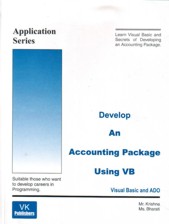
ISBN: 81-901331-0-1
Price: $19.90
Weight: 1.6 Pounds
Pages: 357
Develop An Accounting Package Using Visual Basic
(ISBN:: 81-901331-0-1)
Objective
The objective of this book is to teach the secrets of developing an accounting software package. The techniques of developing an accounting package are taught using business logics, programs, flow charts, and other tools to make learning easy and comprehensive. Note that by reading these books you will be able to independently develop database applications. You will learn how to develop the application using programming techniques ( hard coding ) and not by wizards.
Contents
Part-1: Accounting
- Introduction to Accounting
- Business Transactions
- Financial Position and Accounting Equation
- Accounts
- Use of Accounts
- Types of Commonly used Accounts
- The Double Entry System
- The T Account
- Analysis of Transactions
- The Voucher System
- Steps in Recording Transactions
- Groups
- Transactions
- Financial Statements
-
Trial Balance
DayBook
Typical CashBook
Typical P & L Account
Typical Registers.
- Elements of a Project
- User Interface
- Parts of the Work Space
- Menu Bar
- Project Explorer
- Form
- Properties Window
- Code Editor
- Tool Box Controls
- Data Grid
- Command Button
- Data Types
- Variables
- Declaring Variables
- System Defined Functions
- String Functions
- Date Functions
- Application Enhancement Functions
- Control Structures
- Operators
- Modules
- Procedures
- Events
- SQL
- ADO
- The ADO Programming Model
- Creating a Connection
- Executing a Command
- Recordsets in an ADO environment
- Dynamic recordsets
- Keyset recordsets
- Static Recordset
- Forward only Recordset
- Locks in ADO Environment
- Navigating a Recordset
- Different types of Cursor Locations
- Data Report.
Part-3:Business Logics.
- Programming the Accounts Dialog
- Opening the Accounts Form from the Dialog
- Programming Master Data
- Declaration Section
- Initialize Screen Variables
- Form_Load event procedure
- Form Activate
- Saving Account Details
- Cancel button of Accounts Master
- Checking for Duplication of Account
- How to get a Number from one Table for Storing it in another Table
- Validate Numeric Amount
- Programming the Journal Voucher
- Declarations Section
- Establishing the Connection to the Database
- Opening a RecordSet
- Filtering The RecordSet
- Accepting Multiple Accounts and adding the same to the grid
- Totalling values in a Column of a Grid
- Cancelling Data Entered in a Form
- Deleting Data in the Grid
- Modify Data in a Grid
- How to Create a Temporary RecordSet
- Double Entry Checking
- Forcing Selection of a Item in a Combo Box
- Validating for Numeric Data
- Acheiving Error free/Rapid data entry by Enable/Disable Controls
- Check for Existence of Accounts in the Grid
- Check for Amount Values before Saving
- Saving Transactions
- Updating Tables
- Retreiving Account Reference from Party Table
- To Validate Date Values
- Check for Duplication of Transaction Number
Part-4: Developing the Application
- Accounting Package Outline
- Creating the Project
- Creating the Menu
- Creating Database
- Preparing to Design the Account Form
- Standard Modules to be written
- Designing Accounts form
- Accounts Dialog
- Designing Dialog Form
- Connecting the Dialog to the menu
- Connecting the Form to the Dialog
- Using the Accounts Form
- Journal Form
- Creating the Ltran Table .
- Preparing to Design the Journal Voucher Form .
- Steps of Form Desinging
- Connecting the Journal to the Menu
- Using the Journal Voucher
- Cash Voucher
- Preparing to Design the Cash Voucher form
- Cash Voucher Form Designing
- Connecting the Cash Voucher to the Menu
- Using the Cash Voucher
- Cash Receipt
- Preparing to Design the Cash Receipt Form
- Cash Receipt Form Desinging
- Connecting the Cash Receipt to the Menu
- Using the Cash Receipt
- Purchases
- Preparing to Design the Purchases Form
- Purchases Form Designing
- Connecting the Purchases Form to the Menu
- Using the Purchase Voucher
- Sales
- Sales Form Desinging
- Using the Sales Voucher
- Grid Control
- Daybook
- DayBook Designer Screen
- Designing the DayBook Report
- Code Explanation of DayBook
- Registers
- Code Explanation of Register
- Trial Balance
- CashBook.
Technical Perspective
This book adopts a procedural approach to developing an accounting application. You will see why the procedural approach is beneficial in many situations. The reports and transactions dealt with in this book are specific to an accounting application. Combined with the Object Oriented approach taught in the second title you will be able to mix and match both the techniques while developing applications.
Click here to place your order.